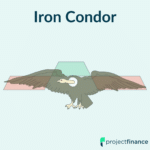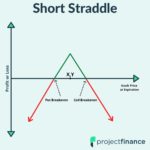Last updated on February 10th, 2022 , 12:42 pm
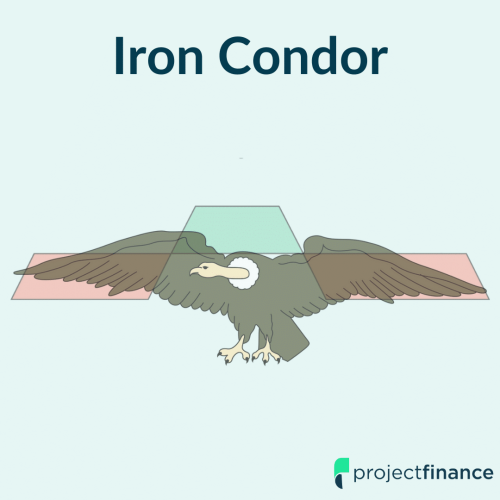
Sometimes, you’ll need to make an adjustment to your option positions when the stock price moves against you.
In this post, you’ll learn about the iron condor adjustment of “rolling down” the short call spread to defend an iron condor.
What You’ll Learn
1. What “rolling down” a short call spread means.
2. How rolling down the short call spread can minimize risk and maximize profits in a troubled iron condor position.
3. The one drawback of rolling down the short call spread to defend the trade.
Let’s get started!
Jump To

New to options trading? Learn the essential concepts of options trading with our FREE 160+ page Options Trading for Beginners PDF.
What is “Rolling?”
In options trading, “rolling” refers to closing an existing option position and opening a similar option position with different strike prices, in a different expiration cycle, or a combination of the two.
Today, we’ll focus on “rolling down” the short call spread in a short iron condor position, which refers to buying back your current call spread and “rolling it down” by selling a new call spread at lower strike prices.
Rolling an Option
The process of closing an existing option and opening a similar option position at different strike prices, in a different expiration cycle, or a combination of the two.
When Do You Roll Down the Short Call Spread?
When trading iron condors, the most typical time to roll down the short call spread is when the stock price falls quickly towards your bull put spread.
Consider the following visual:
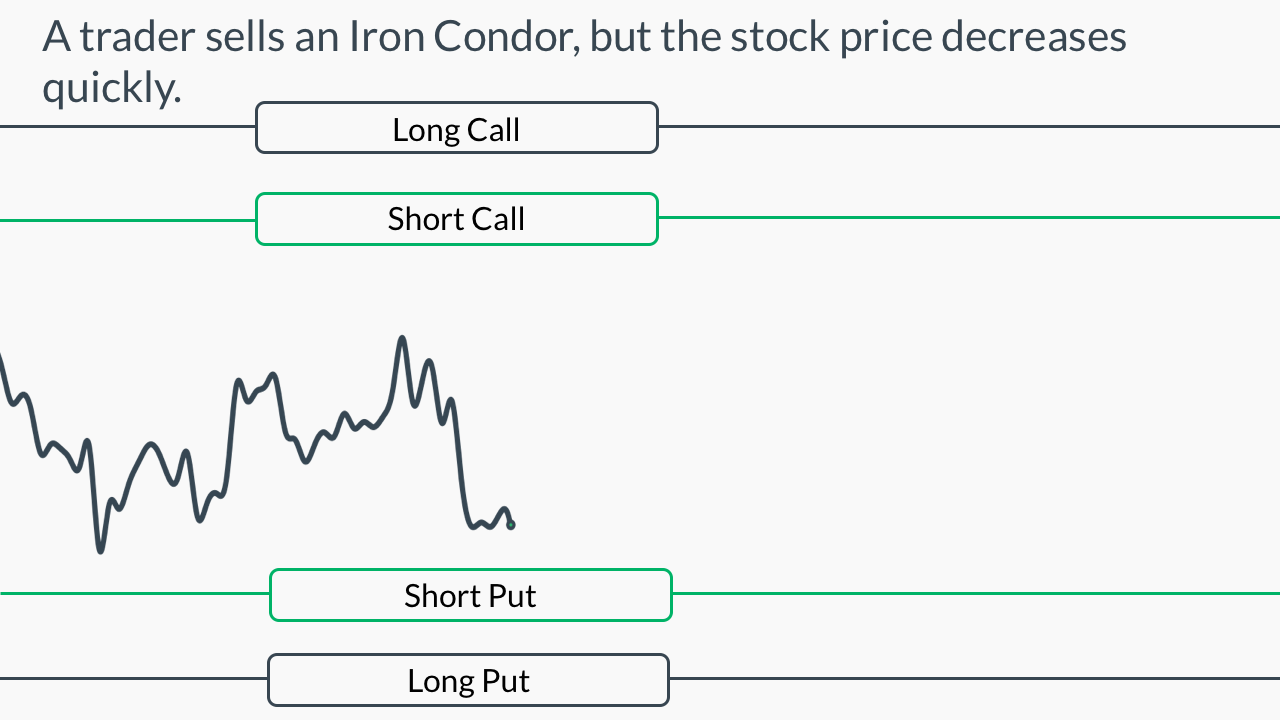
Typically, a short iron condor position will start with no directional risk exposure (position delta is near zero). However, when the stock price falls quickly towards the short put’s strike price, the position’s delta will grow positive, which means the trade has become directionally bullish.
The most common iron condor adjustment to make in this scenario is to roll down the short call spread by purchasing the old call spread (closing trade), and selling a new call spread at lower strike prices (opening trade):
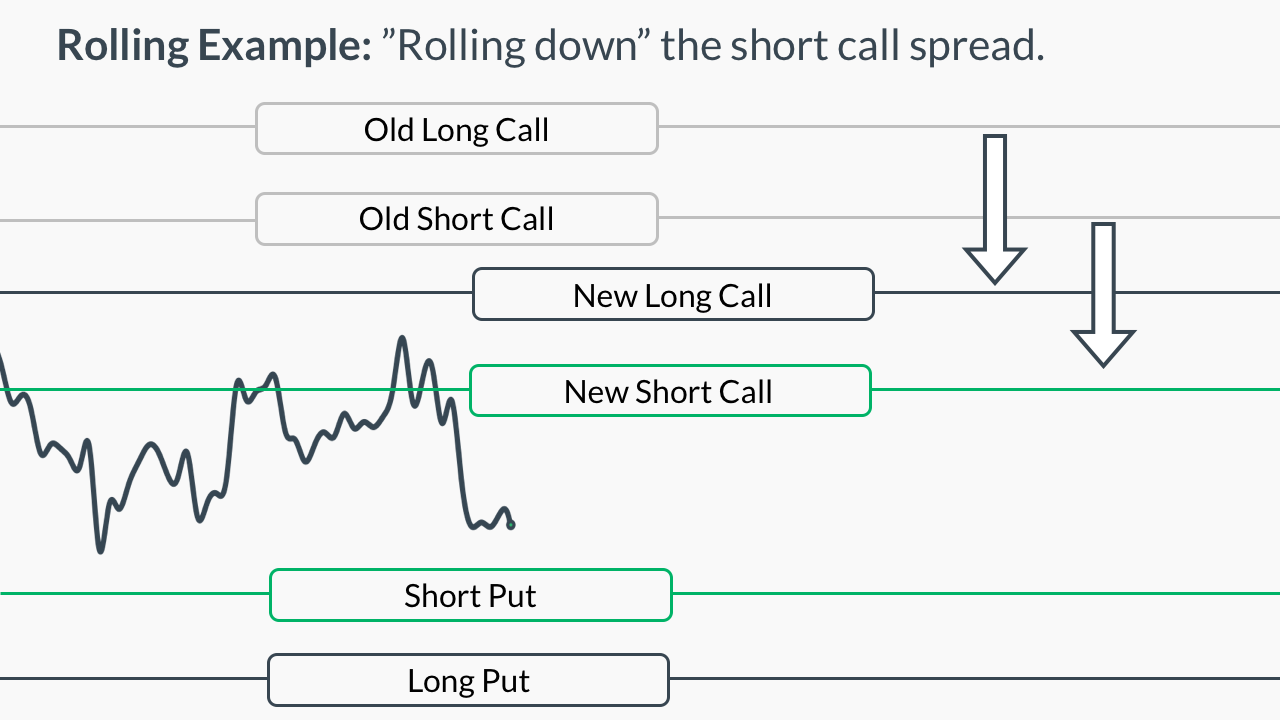
When adjusting an iron condor by rolling down the short call spread, what does the trader accomplish?
What Does Rolling Down the Call Spreads Accomplish?
By rolling down the call spread to lower strike prices, a trader accomplishes two things:
Since call options at higher strike prices are cheaper than call options at lower strike prices, rolling down the old short call spread to lower strike prices is done for a net credit. “Net credit” just means more option premium is collected than paid out.
By collecting more option premium, the iron condor position’s maximum loss decreases by the amount of premium received (assuming the spread widths remain the same). For example, if a $5-wide iron condor is initially sold for $1.00 and the trader rolls down the call spreads for a $0.50 credit, the position’s maximum loss decreases by $0.50 and the maximum profit increases by $0.50.
However, the put spread and call spread are now closer together, which means the iron condor position has a narrower range of maximum profitability.
By rolling down the call spreads, the iron condor’s directional exposure shifts from bullish to closer to neutral.
Why?
At the time of rolling down the call spreads, an iron condor will have a positive position delta, which means the trader will lose money from subsequent decreases in the stock price.
When the call spreads are rolled down to lower strike prices, the new short call spread’s delta will be more negative than the old short call spread, which reduces the iron condor’s position delta.
Let’s cover each of these points in more depth.
#1 Collect More Premium
Consider a trader who is short the 160/165 call spread in their iron condor position but rolls down to the 150/155 call spread:
How much option premium is collected from the roll?
Premium Collected:
$1.82 Collected from 150/155 Call Spread
– $0.53 Paid for the 160/165 Call Spread
= +$1.29 ($129 Less Risk & $129 More Profit Potential)
By rolling down the short call spread, the trader collects $1.29 in additional option premium. With $1.29 more option premium collected, the iron condor has $129 more profit potential and $129 less loss potential.
However, since the new call spread is now closer to the put spread, the position has a much more narrow range of maximum profitability, which makes it a lower probability trade.
#2: Neutralize Your Position Delta
At the time of the roll, let’s say the trader’s position delta is +20. Here’s how the position delta would change after the roll:
Let’s break down the differences in each call spread’s delta and see how the new call spread changes the iron condor’s directional exposure:
Short 160/165 Call Spread Delta: -8 (-17 Delta Short Call + 9 Delta Long Call)
Short 150/155 Call Spread Delta: -17 (-47 Delta Short Call + 30 Delta Long Call)
Change in Call Spread Deltas: -9
New Iron Condor Delta: +20 – 9 = +11
To clarify, the call spread deltas are calculated with the following formula:
(Short Call Delta x -1 Contract x 100 Option Multiplier) + (Long Call Delta x +1 Contract x 100 Option Multiplier)
After rolling down the call spread, the iron condor’s delta exposure changes from +20 to +11, which means the iron condor is now 45% less sensitive to small changes in the stock price.
More specifically, the trader is only expected to lose $1 with a $1 decrease in the stock price as opposed to a $20 loss before the iron condor adjustment.
What’s the Risk of Rolling Down the Call Spreads?
While rolling down the short call spread has its benefits (higher maximum profit potential, lower loss potential, reduced directional exposure), there are some downsides:
An iron condor’s maximum profit zone lies between the short call and short put strike price. After rolling down the call spreads, the short call and short put strike prices are now much closer, which results in a much narrower range of maximum profitability.
By neutralizing the iron condor’s directional exposure, a subsequent rally in the stock price will yield less profits (or even losses) than before rolling down the call spreads.
As with any trade adjustment, there are benefits and downsides. The iron condor adjustment strategy of rolling down the short call spreads decreases the loss potential, increases the profit potential, but ultimately makes the trade a lower probability position since the maximum profit zone is now tighter.
Concept Checks
Here are the essential points to remember the iron condor adjustment of rolling down the short call spreads:
1.When selling iron condors, if the share price falls towards your short put spread, you can adjust the position by “rolling down” the short call spreads. | |
|---|---|
2. By rolling down the old call spreads, you collect more option premium, which increases the maximum profit potential and decreases the maximum loss potential. | |
3. The downside of rolling down is that you decrease your probability of making money (tighter range of profitability), and make less money (or potentially lose money) from subsequent increases in the stock price. |
projectfinance Options Tutorials

About the Author
Chris Butler received his Bachelor’s degree in Finance from DePaul University and has nine years of experience in the financial markets.
Chris started the projectfinance YouTube channel in 2016, which has accumulated over 25 million views from investors globally.


